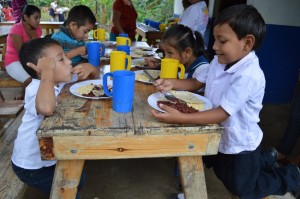Scaling up the Brazilian school feeding model
I frequently visit projects which are transforming the lives of hundreds and sometimes thousands of people – by increasing crop yields, reducing malnutrition, restoring degraded lands, providing better access to education and healthcare. However, all too often these projects are confined to small areas and the question remains: how can they be scaled up to benefit hundreds of thousands or even millions of people?
In 2014, the UN Food and Agriculture Organization (FAO) asked me to write a booklet about Brazil’s school feeding programme and the influence it is having on other countries in Latin America. This is an excellent example of South-South Cooperation; of tried and tested solutions in one country being adopted in others.
In 1990, 14.8% of people in Brazil suffered from hunger; the figure is now just 1.7%. This remarkable transformation owes much to the country’s school feeding programme, which supplies some 43 million pupils with one or more servings of food per school day. By law, at least 30% of the food must be sourced from family farms, thus providing significant benefits to over 120,000 rural families.
The Strengthening of School Feeding Programmes in the Framework of the Hunger-Free Latin America and Caribbean 2020 Initiative – a trilateral project involving Brazil, FAO and 13 other countries in the region – is now helping governments to roll out similar programmes in other parts of the continent. This booklet focuses on the experience in Nicaragua and El Salvador. During a short period of time, this approach has led to better nutrition among schoolchildren and significant improvements in the income and welfare of family farmers.
